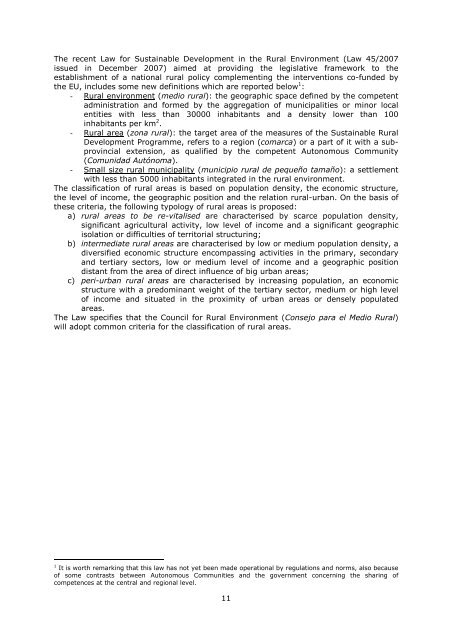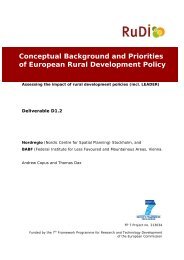Country profile on rural characteristics Spain - RuDI
Country profile on rural characteristics Spain - RuDI
Country profile on rural characteristics Spain - RuDI
- No tags were found...
You also want an ePaper? Increase the reach of your titles
YUMPU automatically turns print PDFs into web optimized ePapers that Google loves.
The recent Law for Sustainable Development in the Rural Envir<strong>on</strong>ment (Law 45/2007issued in December 2007) aimed at providing the legislative framework to theestablishment of a nati<strong>on</strong>al <strong>rural</strong> policy complementing the interventi<strong>on</strong>s co-funded bythe EU, includes some new definiti<strong>on</strong>s which are reported below 1 :- Rural envir<strong>on</strong>ment (medio <strong>rural</strong>): the geographic space defined by the competentadministrati<strong>on</strong> and formed by the aggregati<strong>on</strong> of municipalities or minor localentities with less than 30000 inhabitants and a density lower than 100inhabitants per km 2 .- Rural area (z<strong>on</strong>a <strong>rural</strong>): the target area of the measures of the Sustainable RuralDevelopment Programme, refers to a regi<strong>on</strong> (comarca) or a part of it with a subprovincialextensi<strong>on</strong>, as qualified by the competent Aut<strong>on</strong>omous Community(Comunidad Autónoma).- Small size <strong>rural</strong> municipality (municipio <strong>rural</strong> de pequeño tamaño): a settlementwith less than 5000 inhabitants integrated in the <strong>rural</strong> envir<strong>on</strong>ment.The classificati<strong>on</strong> of <strong>rural</strong> areas is based <strong>on</strong> populati<strong>on</strong> density, the ec<strong>on</strong>omic structure,the level of income, the geographic positi<strong>on</strong> and the relati<strong>on</strong> <strong>rural</strong>-urban. On the basis ofthese criteria, the following typology of <strong>rural</strong> areas is proposed:a) <strong>rural</strong> areas to be re-vitalised are characterised by scarce populati<strong>on</strong> density,significant agricultural activity, low level of income and a significant geographicisolati<strong>on</strong> or difficulties of territorial structuring;b) intermediate <strong>rural</strong> areas are characterised by low or medium populati<strong>on</strong> density, adiversified ec<strong>on</strong>omic structure encompassing activities in the primary, sec<strong>on</strong>daryand tertiary sectors, low or medium level of income and a geographic positi<strong>on</strong>distant from the area of direct influence of big urban areas;c) peri-urban <strong>rural</strong> areas are characterised by increasing populati<strong>on</strong>, an ec<strong>on</strong>omicstructure with a predominant weight of the tertiary sector, medium or high levelof income and situated in the proximity of urban areas or densely populatedareas.The Law specifies that the Council for Rural Envir<strong>on</strong>ment (C<strong>on</strong>sejo para el Medio Rural)will adopt comm<strong>on</strong> criteria for the classificati<strong>on</strong> of <strong>rural</strong> areas.1 It is worth remarking that this law has not yet been made operati<strong>on</strong>al by regulati<strong>on</strong>s and norms, also becauseof some c<strong>on</strong>trasts between Aut<strong>on</strong>omous Communities and the government c<strong>on</strong>cerning the sharing ofcompetences at the central and regi<strong>on</strong>al level.11



